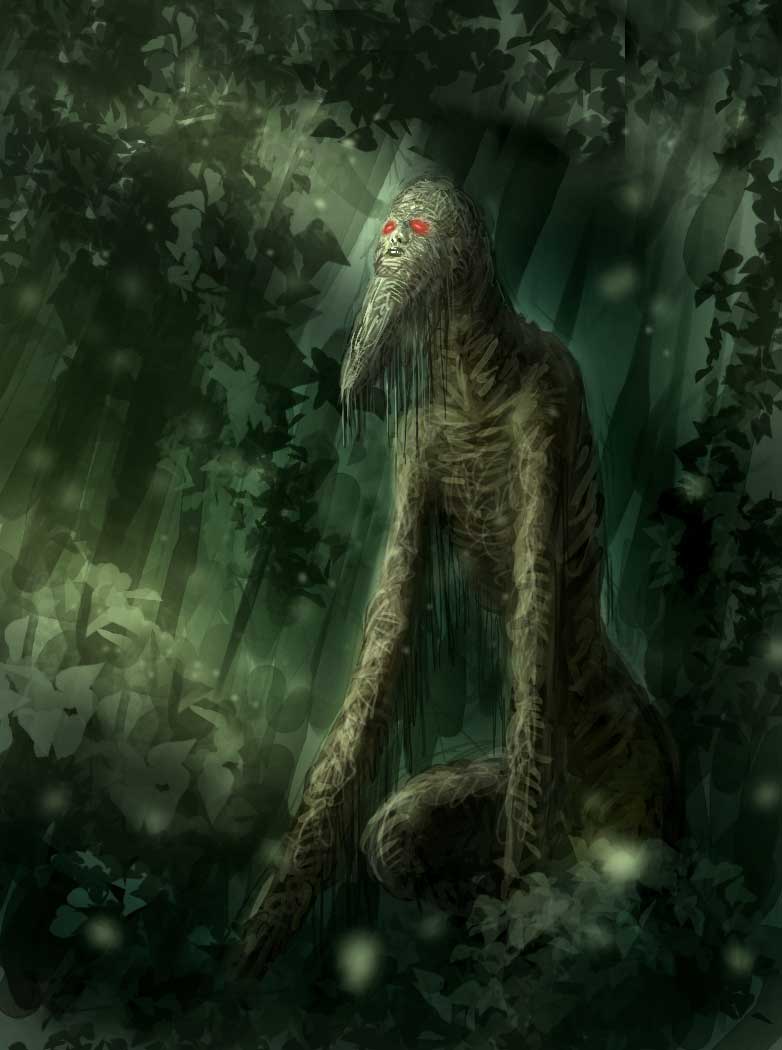One of the most popular and enduring mythical creatures in Filipino lore. The tikbalang is said to be a half human, half horse creature in the mold of the Greek Pan, that is, having an upper body of a human and lower limbs of a horse (check out my original drawing above ^). There are two known versions of the creature’s appearance: the more popular and oft portrayed version has the tikbalang with the head of a horse while the lesser known version has it sporting a human visage. Both versions however agree that the tikbalang has unusually long, powerful legs that resemble the rear quarter of a horse, hooves and all.
< As far as I know, the word tikbalang is universally understood throughout the Philippines although there might be other regional variations of its name that I don't know of. As for the etymology of the word, I'm not that sure, really. In tagalog, a balang is a locust. Of course, we all know that locusts have relatively long hind legs so I'm wondering if this has got something to do with the portrayal of the tikbalang as hunched over with legs folded, knees taller than its shoulders. It would sure look like an oversized locust somehow.
Tikbalang Stories
I know a couple of people who had tikbalang stories. One of them is my father. When he was a teener living in Antique he mentioned one particular night when two of his brothers were quarreling and socking each other outside their hut after a late evening drizzle. You can hear shouts and a dull thud here and there. After sometime, their mother broke up the fight and asked them to sleep away their tempers and change their clothes for the night. The two grudgingly obliged. A few hours later, there were dull thuds all over again, this time however, the sound shifted from one side of the house to the other. Father said the last time he checked, both his elder brothers were fast asleep, tired from their fisticuffs earlier. Who or what could be making the sound outside? He tried to sneak out of the back door to check but his mother, who was still awake and sitting near the window, stopped him and told him nonchalantly that he should stay inside as “there’s a tikbalang outside”. He obeyed and made sure that everyone was inside at the time. My father was the 7th of nine siblings by the way, and everyone except for himself and my grandma was fast asleep already.

Still the dull thud-thud-thud continued, one at a time on each side of the house. He describe the sound as akin to the sound of the heavy pestle used for separating the rice chaff from the grain. He was forbidden even to sneak a peak at the window so he can only imagine what it looked like. Apart from the dull thuds, there was no other sound to hear except the stridulation of crickets and cicadas. He fell asleep to the sound of the “tikbalang” jumping like crazy outside.
The next morning he woke up to find that their neighbors and relatives were all milling around a strange sight: huge hoof impressions, each the size of ripe coconut littered each side of the house. the impressions came in pairs and overlapped each other. Each mark was several inches deep and filled with rainwater from last night’s drizzle. No one owned a horse in the barrio and not even a thoroughbred bronco can make impressions that big. It’s clearly not a buffalo’s since the hoof is not cloven in the middle. Whatever made those impressions would be immensely bigger and heftier than a carabao or a horse judging from the depth and size of the impressions. The fact that the impressions came in pairs suggest a bipedal creature left those marks. Granting that this thing had legs proportionate to a horse and the torso of a human relative to its legs, it could’ve easily scraped the ceiling at around 10-15 feet tall.
Unfortunately, no one had a camera at the time. Which was understandable considering that the area was so poor at the time some students had to walk unshod to and from school just to make their precious “bakya” last longer. Umbrellas were expensive and were almost unknown so if it rained, people used banana leaves instead. The blessings of Tesla’s electricity still hasn’t reached those parts yet (this was in the early 60’s).
What was the tikbalang’s business jumping over the roof at those late hours? What it did was similar to the Filipino chidren’s game called “Luksong Tinik” lit. “Jumping Thorns” but its motives were never known. Tikbalangs have been known to be playful and mischievous so it’s anybody’s guess.
I only wish I was there. I could’ve punched a small hole on the wall and taken a peek, but after a night of rains (cloudy sky, no moon, no electricity) I don’t think I can make out much, if anything at all.
Check out THE ASWANG PROJECT’s Tikbalang Documentary!
Blogger, Researcher, Philomath, Artist


